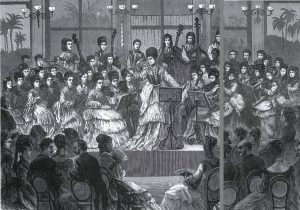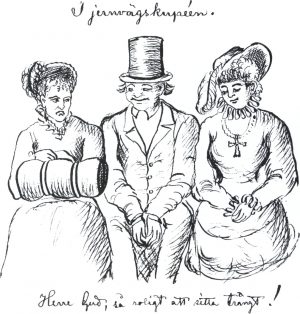
Fredrika Bremer’s novel Hertha (1856; Eng. tr. Hertha) has the subtitle “en själs historia” – that is, ‘the story of a soul’ – and the novel describes women as “captive, struggling souls […] which are yearning after life and light”. Thirty-two years later, Victoria Benedictsson wrote “Den bergtagna” (1888; The Bewitched), which might have been called ‘the story of a body’, for this posthumously published prose piece is the document about ‘free love’, written as a contribution to the period’s discussion of the degree of accessibility to the female body.
From the point of view of the middle-class women’s movement, the new sexual morality was a questionable improvement. Marriage offered life-long social protection to women and children. In free love relationships there were no corresponding guarantees. And how were women to avoid feeling the consequences of the man’s traditional contempt for those women who allow themselves to be sexually exploited?
Axel Lundegård estimated that seventy-five per cent of the men in Victoria Benedictsson’s surroundings had, or had had, syphilis, as a direct result of visits to prostitutes. The new sexual morality was meant to make it possible for middle-class men to have extra-marital affairs with ‘pure’ women of their own social class. Ola Hansson’s Sensitiva amorosa (1887; Eng. tr. Sensitiva amorosa) mirrors well the chaos that could arise in the male imagination when these two distinct types of love experiences were to be described as only one. In the fantasy, the whores and the fiancée melt together to one and the same fatally infectious and ominously expansive female body.
“He saw how her form was dissolving, the lines of her face slackening, the skin pale gray, the process of dissolution had begun in the organism; he saw […] the cold voracious smile around those thin colorless lips. […] As the surgeon submerges his instrument into the body mass […] he submerged his mind into that smile in order to cut out the mystery of her being and ascertain its strange structure. But the instrument always slipped in his hand […] however anxiously intent he glided with all of his being into hers.”
From Ola Hansson’s Sensitiva amorosa (1887; Eng. tr. Sensitiva amorosa).
Victoria Benedictsson loses her last ally, Axel Lundegård, when she refuses to share his admiration of Hans Jæger’s Fra Kristiania-Bohemen (1885; From the Christiania Bohemia). But although Victoria Benedictsson is uncompromising in her repudiation of the advocates of ‘free love’, she is herself a true Modern Breakthrough author. She does not shy away from addressing the most forbidden issues. It is not the ideas of the time but the conditions of the body in the new morality that increasingly becomes her great theme. She becomes a modern author when she succeeds in combining the experiences of her own body with her strong feelings concerning the decisive question of whether a man and a woman can be united in a manner that is dignified for them both. The body becomes her instrument and artistic barometer, and she minutely registers its signals. The experiment is risky and requires her to beard the lion in his den. With her steel pen poised, she aims at the advocate of the Modern Breakthrough, Georg Brandes. Each and every word exchanged between them she notes down, and even more.

Due to his position as a critic and lecturer, Georg Brandes is the big attraction of the time, and through her relationship with him Victoria Benedictsson arrives at the very centre of the literary 1880s. She is going to learn to her cost how rotten it is at its core. In Victoria Benedictsson’s diaries, Brandes becomes the personified spirit of the time. One moment he lures her with his friendship and his encouragement of her writing; the next moment he comes across as a sordid, commonplace eroticist. What is clear is that it is he who defines how a ‘modern’ woman must be and, above all, what ‘free love’ is:
“You pay your wife three hundred crowns a month for her love, and that is considered correct. Or you pay other women, and that is considered correct, too. The only thing that is not allowed, that’s when you don’t pay, that’s free love. Bear this in mind.”
Through Brandes, Victoria Benedictsson is able to experiment with free love and its consequences. As a human being she suffers – but as a woman she submits – when he dictates the terms. At the same time, as an author she is ready to give her life for the right to define her own experience. There is an ill-fated compulsiveness in her infatuation. The relationship soon develops into trench warfare, in which the representative of the stronger sex slowly but surely wins ground from the isolated author, who thirsts for recognition. The diary not only registers the seduction (and the cheap technique of sexual blackmail) but also, in detail, its effects on the female body:
“Georg Brandes kissed Ernst Ahlgren. Amazingly enough, all I felt was a certain fear and disappointment. Not the refined passion that I had imagined. It was precisely the same kind of kisses that my husband had taught me to detest. I felt cool, moist lips around mine, felt teeth being pressed towards mine, this disgusting thing that is voracious without warmth. In a word: the spark was totally missing. Why? Was it his fault or mine?”

Victoria Benedictsson takes one step further than her female colleagues when she points out the price to be paid for the period’s ‘free love’, namely the obliteration of female desire and the destruction of the female body. The man – per (recent) definition: the only human subject – is placed in a traditionally female position as a (sexual) object, when Benedictsson gives her description of Brandes, the genius, as a lover (and an insufficient one at that). This turns out to be a scandalous truth that attacks the very core of his male self-esteem. In her zeal for truth, as a ‘modern’ author who does not shy away from taboos, she overlooks the patriarchal resistance. She takes Brandes at his word, one might say, when she wants to submit even these problems to debate, in accordance with his own modernist program. Unsuspectingly, Victoria Benedictsson candidly presents the critic with a description of their encounter:
“I walked up to his desk and handed him the sheets of paper. Cursed be that day, that month, that hour! He took those confounded sheets and went up to the lamp, sat down, and began to read. The expression on his face was shifting: disapproval, irony. I felt dead inside; I was merely curious. […]
“Then he turned around; he had finished reading. What an expression on his face! – cold, disapproving, unfriendly. Fear grabbed hold of my throat with cold fingers. Only now could I see what I had done, what I was going to lose. He looked at me. That gaze chilled me to the marrow, like icy coldness. I don’t know what I did; I think that I stretched my hands towards him and cried: ‘Forgive me, forgive me!’ But I clearly remember the gesture of disgust with which he deprecatingly raised his hand, while looking at me as at a loathsome animal.”
Georg Brandes completely misses the point. To him, private matters are not of the slightest literary or political interest. Victoria Benedictsson is first and foremost sexual quarry, a feather in his cap. He is the man who chose to write about The Men of the Modern Breakthrough (1883; Danish orig. Det moderne Gjennembruds Mænd, 1883) and to forget about the women of the Modern Breakthrough, all of whom, as the Danish literary scholar Pil Dahlerup has pointed out, were acquainted with him – as mistresses, friends, and supporters.
In a letter of 1910 to the female historian of literature, Helmi Krohn, in Finland, Georg Brandes grumbles, apropos of the whole Victoria Benedictsson affair: “I just want, then, to say the following: I don’t think that you can imagine the position I have been in for years as fair game for the curiosity of writing women. Dante ought to have devoted a circle in his hell to the critic’s position with regard to the women worshippers of Apollo and Dionysus […]. I don’t think that you can know the weak sides of your sex in the same way as a critic gets to know them.”
Georg Brandes wanted to teach Victoria Benedictsson a lesson. She becomes “a loathsome animal” when she does not recognise that it is he who is the only seeing subject. His disgust is so strong that she destroys the manuscript. From then on, she seemingly plays his game, but in secret she notes down the further course of events. In the final phase of the relationship, Benedictsson begins to write in the third person, which gives a pronounced literary form to the erotic situations:
“She threw off her clothes, trembling with fear but determined to keep her word. When she was half done, he opened the door. She gave a leap when she saw him [in] the white linen. Her eyes had gotten used to the darkness; she could clearly see his face, which was smiling.”
It is obvious that Victoria Benedictsson is well on her way to turning her sexual experiences into fiction. At the same time, she is fully aware that this is what is most forbidden. Stora boken (The Big Book) is a unique documentation of the historical moment when the female object becomes a subject and, threatened with extermination, begins to speak. For this insight and for this work of art, Victoria Benedictsson paid with her life.
Victoria Benedictsson was not able to portray a ‘free’ woman who had full access to both intellect and sexuality. Both because this kind of experience hardly existed in the Nordic countries in the nineteenth century, and because the objectification of the woman lies latent in the written language of the domineering male culture. Instead, the future image of the woman can be discerned in the tension between the different types of women, representing different life alternatives. The female author invests her own divided self and allows her masochistic self-hatred, which is in violent strife with her equally strong, rebellious ambition, to manifest itself in the texts and develop into characters as incompatible as Mrs Benedictsson, wife of the postmaster, and ‘Ernst Ahlgren’, the male pseudonym that she occasionally also uses as her alter ego in the diaries.
Translated by Pernille Harsting

